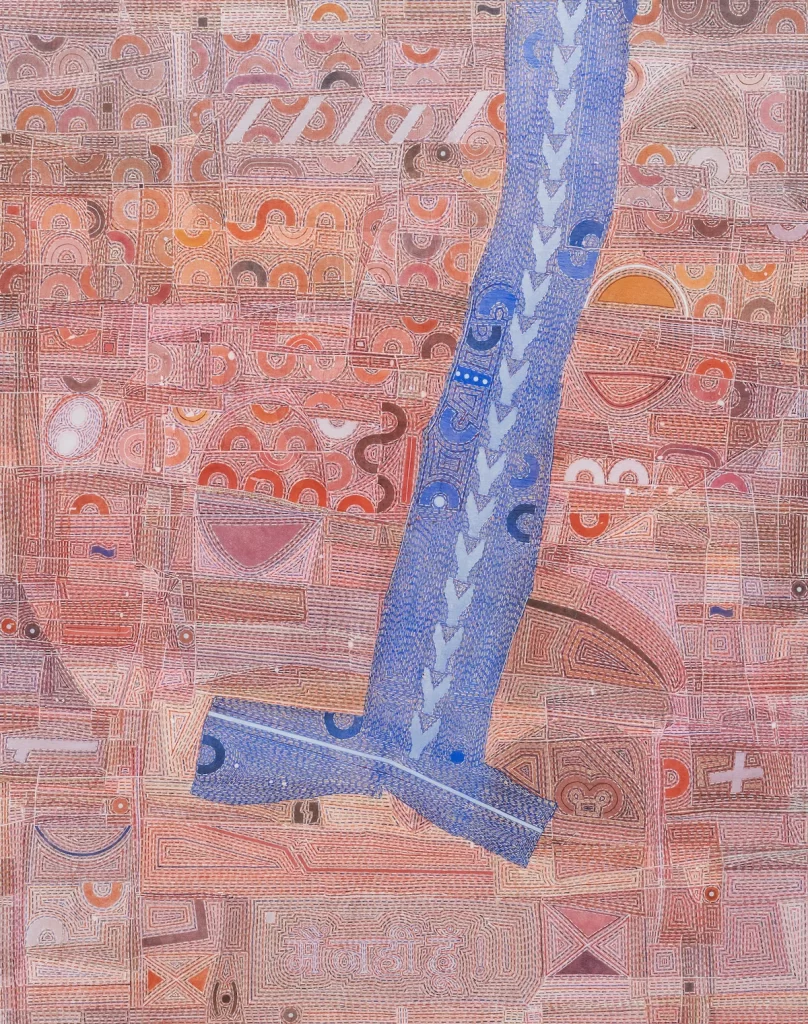In Sparsh Rekha (The Tangent Line), Manish Pushkale presents a series of works that play with notions of the tangible and intangible, the remembered and imagined. Pushkale, known for his meditative abstractions, zeroes in on the “in-between” spaces captured in the exhibition title, one where a straight line touches yet never fully meets a curve.

The exhibition, which curator Siddhi Shailendra describes as an “interlude” in Pushkale’s artistic evolution, is a time for reflection and transformation. Each work in this series meditates on the dynamics of form, texture and the “stitch,” which recurs throughout the work and is a motif that signifies connection, rupture and continuity.
How can we embrace visual language and materiality?
Pushkale’s canvases, including Within Excavation I and The Flying Pebble, reveal an advanced sense of materiality. There are layers of acrylic and mixed media, shaped with precision, that suggest geological topographies or ancient maps. Textured stitches course across these surfaces, both creating patterns and prompting viewers to “fill in the blank.” This nothingness becomes an imagining—a blank hush in which Pushkale invites reflection.

The diptych Memory of Lost Moon and the large-scale piece Sparsh Rekha explore a rhythmic dialogue between curves, lines, and delicate shifts in chromaticity. The works invoke an archaeological consciousness, in an excavation of time in which the artist’s passions for geology seep through in formations that are both permanent and impermanent.

A Philosophical Journey
A key concept in Pushkale’s practice is “swabhava,” or intrinsic identity, from Indian aesthetics. Through Uttsarg-Cheshta, Pushkale invites the audience to find the personal in the universal. His lines, supple but with deliberation, evoke a journey across civilisation’s palimpsests. These forms recall organic things: flowing water, stones forgotten behind walls, the pieces of celestial beings.

In pushatastak, Pushkale is not simply “representing” but is having a quiet conversation with her audience. It’s contemplative rather than chaotic abstraction, with space for stillness and contemplation.
Conclusion
Manish Pushkale’s Sparsh Rekha is a deeply introspective investigation into thresholds between stillness and movement, form and void, past and present. The show is an expression of Pushkale’s maturity as an artist who sacrifices his own peace in order to find new territories of expression. This interlude, as the curator calls it, is a vital pause in his journey — a moment for the viewer to inhabit the spaces he constructs so deftly.

Venue: Akar Prakar, New Delhi
Dates: 16th December 2024 – 17th January 2025
Curator: Siddhi Shailendra
Feature Image: The Flying Pebble by Manish Pushkale| Courtesy: Akar Prakar

Iftikar Ahmed is a New Delhi-based art writer & researcher.





